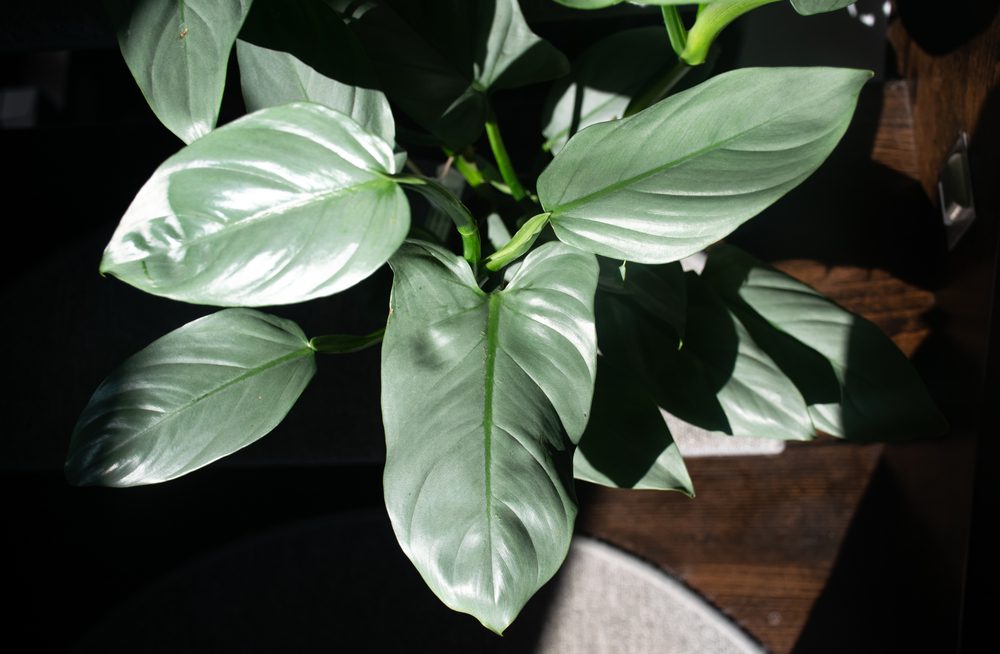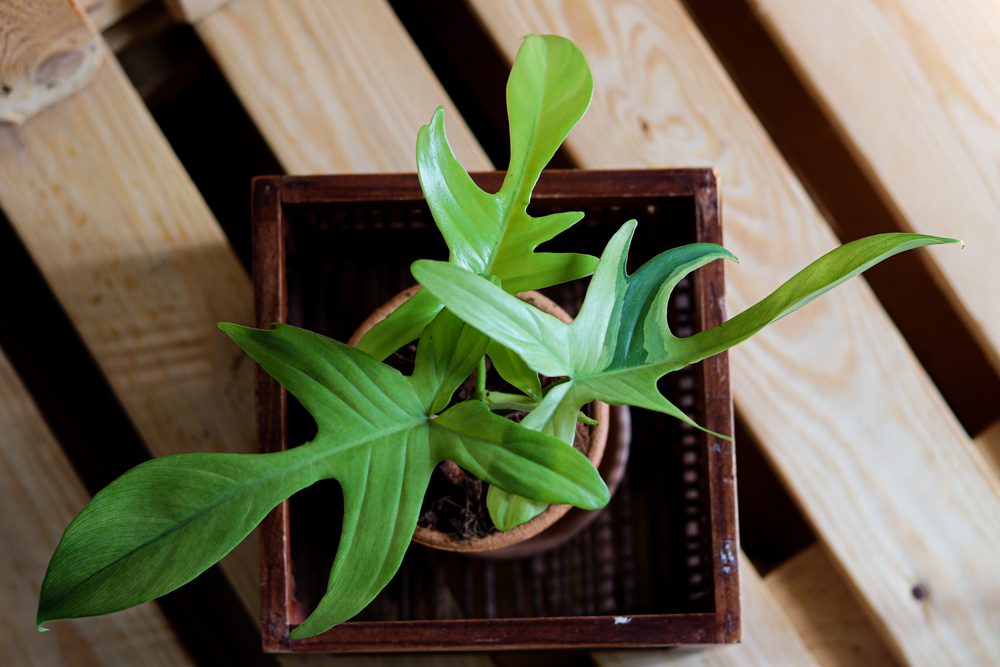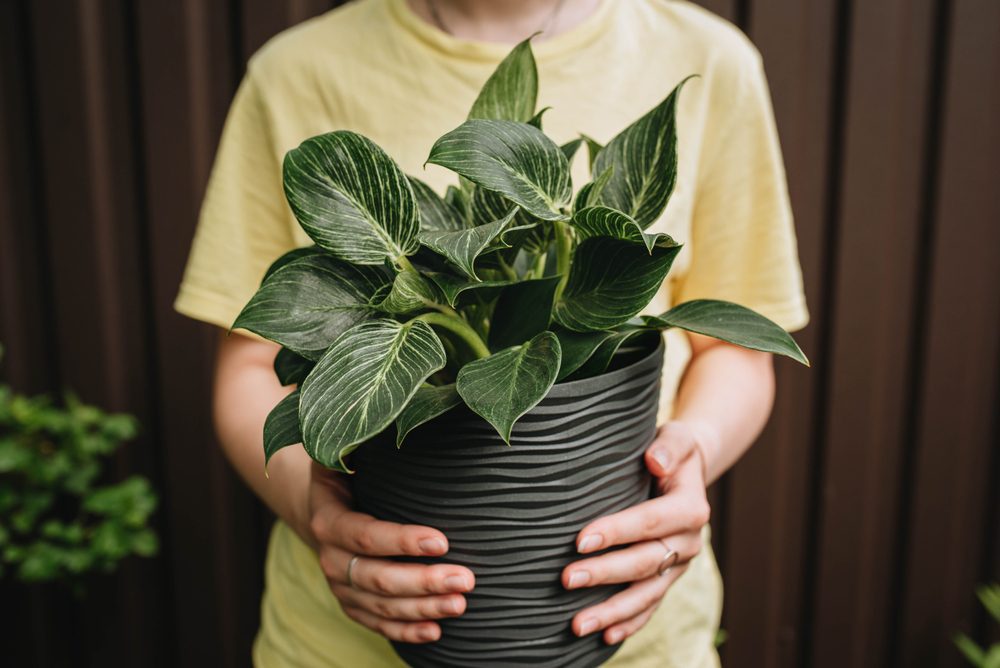A philodendron is by far one of the biggest genera of flowering plants, that originally came from the Araceae plant family. The majority of Philodendron varieties can easily live without direct sunlight, as they came from extremely humid rainforests.
It’s also one of the main reasons why Philodendrons do very well as indoor plants, for indoor gardens and any other shade-based gardening space.
A philodendron’s appearance might differ, depending on its age and species. However, in general, the color can be white, red, or green. Some philodendron leaves might even look purplish or coppery.
Given that there are so many types of Philodendron, it’s extremely unlikely to predict the plant’s appearance and color.
Even more, the way a Philodendron grows can solely depend on the variety. Some varieties might grow by fixing themselves to other plants, while others stay as an epiphyte for their entire life. Here are a couple of Philodendron types that we personally prefer and love:
Philodendron Hederaceum
Also known as the classic beginner’s plant, no other than the famous Philodendron Hederaceum, which is also known as the Heartleaf Philodendron. This plant has trailing vines grace hanging baskets all over the world.
It has an extremely fast growth rate, with its beautiful heart-shaped leaves that can grow up as high as three inches when trailing. Even more, they can grow up as much as eight inches wide, if they are allowed to climb.
It makes a beautiful hanging plant with vines that can go as much as five feet when it’s grown indoors. Philodendron Hederaceum is extremely adaptable to any range of humidity or light levels. That’s why it’s known as a beginner plant because it requires very low maintenance.

Philodendron Silver Sword
Also known as Philodendron Hastatum, this plant is an extremely bold type of Philodendron, with extremely long, arrowhead-shaped foliage. The leaves are naturally gray-green, with a specific metallic sheen.
They can grow up as much as two feet in length, and up to nine inches wide. Its vines can reach over 10 feet long. This is definitely one of the pretties Philodendron types you could buy.
The plant is also known as Spadeleaf. These species are oftentimes mistaken for Fastifolium, Elongatum, Glaucophyllum, and Domesticum.
Philodendron Silversword has this specific narrow-leaf version and only a few variegated hybrids, which might also include Lemon Lime and Silver.
Split Leaf Philodendron
It is botanically known as Thaumatophyllum Bipinnatifidum, and it belongs to the Thaumatophyllum species. At times, it can also be referred to as Lacy Tree Philodendron, Philodendron Selloum, Horsehead Philodendron, or Philodendron bipinnatifidum.
The plant comes from South American countries, such as Bolivia, Argentina, Brazil, and even Paraguay. Split Leaf Philodendrons are extremely popular houseplants in some temperate regions. And truth to be told, they make an awesome landscape plant in subtropics, tropics, and even warmer areas in the U.S.
You’ll definitely find this plant more in warmer states like Florida and California. In the wilderness, it can grow up as much as 15 feet in height, with a woody stem that’s similar to a trunk.
The stem can reach up as much as six inches in diameter. It’s extremely similar to Monstera, as the plant displays a hemiepiphyte growth characteristic and can occupy a large area around it.

Philodendron Pedatum
Philodendron pedatum, which is also known as Oak Leaf Philodendron, is a strangely unique climbing Philodendron variety. It casually sports green leaves that change their shape once they’ve reached maturity, which makes it one of the most unique types out there.
The leaves with a small and oval shape, and they gradually develop deep lobes as they grow. When they’re grown indoors, the leaves might reach up to nine inches long.
Philodendron Bloody Mary
This Philodendron variety is famously known for its striking leaves and extremely vibrant stems. The baby-growing leaves usually start developing a reddish hue and then grow into their typical green leaves as they start to mature.
The leaves are very long, pointy, smooth, and veined. They all grow in all sorts of directions. The more the leaves are getting mature and longer, the more they droop.
What’s extremely interesting about these leaves is that they also have a red-burgundy undertone, that’s filled with red fluid, hence the name “Bloody Mary”.
If you give it enough care and the proper growing environment, it will spread up to 9 inches and up to 12 feet in height. Even so, this kind of growth will solely depend on how you grow it and the plant’s capacity.
Philodendron White Knight
This plant is oftentimes confused with Philodendron White Wizard, for reasons that are easy to understand. It has extremely elegant variegated heart-shaped leaves, that are nothing less than mesmerizing, and it’s not so easy to be found, either.
Philodendron White Knight is known to be a slow climber, but it tends to grow many feet high if it has the proper structure.
Philodendron Imperial Green
This incredibly spirited, bush-like Philodendron variety has vibrant nuances of green, with broad leaves that can grow very big. Philodendron Imperial Green is very happy with a bit of indirect sunlight that other types of Philodendron types would prefer.
Even if these species can climb, lots of gardeners will allow their Philodendron Imperial Green to develop more like a clumping shrub. This basically means that the new foliage starts with a bright light color, and darkens the more the plant matures.
Even more, the differing shades add a bit of interest when they are massed together. This Philodendron variety can be found anywhere, especially online, and is very different compared to other Heartleaf Philodendron.
If you’re a new grower, we strongly recommend you start with a Philodendron Imperial Green. Make sure you check this plant care guide.

Philodendron Birkin
It’s very easy to understand why this type of Philodendron is so beloved by many growers all over the world. It has pin-stripe variegation over a dark green background with a marvelous radial pattern.
Even more, this plant’s natural variability basically implies that each and every leaf is a bit different. Lots of growers have a wonderful time discovering how each leaf will turn out.
Even if Philodendron Birkin seems to be a fancy one, it’s actually a very low-maintenance plant. It doesn’t grow very fast, but it can reach a height up to two feet tall.
Philodendron Lemon Lime
This cheerful, yellow-green Philodendron type is a cultivar of the well-known Heartleaf Philodendron. It has the basic traits of the common Heartleaf, with striking leaves that will make it the perfect indoor houseplant.
It is extremely beautiful, with unique colors that are particularly impressive, as you’ll basically have a fountain of bright leaves drooping from a thickly planted hanging container.
Philodendron Gloriosum
Philodendron gloriosum originally comes from Columbia. It has contrasting vein structures, that highlight the plant’s big heart-shaped foliage.
The leaves can reach up to three feet wide in the wild. New leaves will unfurl with pink veins that will fade as the plants mature. Philodendron Gloriosum grows a creeping rhizome and thrives very low to the ground, which gives the plant shorter and tidier internodes.
Generally, Philodendron Gloriosum is very easy to take care of. Even so, it can’t really tolerate cold or wet temperatures. The plant looks quite fragile when it’s young, but it becomes sturdier as it grows.
If you enjoyed reading this article, we also recommend reading: 10 Best Low-Maintenance Houseplants